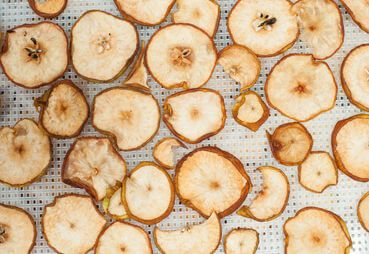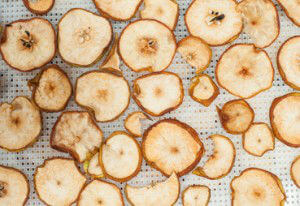
Penny asks: How do I pick the best food dehydrator?
Picking the best food dehydrator can save you lots of time and effort. Base your choice on heat and airflow, access to food, and versatility.
Heat and Airflow
The heat of your dehydrator and the amount of air flow will determine exactly how well your dehydrator will perform. Uneven airflow will cause some food in the dehydrator to be too dry, while other food is still moist. Uneven heat can cause something not to dry completely through.
Shelf dehydrators have very even air flow. The heat source is in the back of the machine and the air flows across each tray. Some low cost stackable dehydrators have the heat source in the bottom of the machine. This causes uneven drying. Other higher quality stackable models, however, have a center mounted dryer for more even dehydrating.
Access to Food
You will need to be able to easily access your food while it is drying to check on its progress. You will also want a dehydrator that allows you to easily place items inside, and remove them. Shelf dehydrators are much more accessible than stackable ones. Each tray easily slides out to allow you to see every row of food.
With stackable dehydrators, each tray is stacked on top of another. This means when you want to reach a bottom tray, each of the top trays will have to be removed and the whole drying process is postponed until you reconstruct the tower. Smaller dehydrators with 4 or 6 trays are fairly easy to work with, but larger styles of stackable dehydrators are much more difficult.
Versatility
You want to purchase a dehydrator that you can use for all things, not just meat or fruit, but anything that can be dehydrated. Shelf dehydrators usually offer the best space for dehydrating larger items because you can remove trays to make a higher shelf space below.
 However, once you use all the space, these dehydrators cannot be expanded. Most manufacturers of stackable dehydrators offer single trays for purchase. So, when you run out of space, you can simply add on a few more trays. This gives you the freedom to dehydrate more things at once, but not necessarily bigger things.
However, once you use all the space, these dehydrators cannot be expanded. Most manufacturers of stackable dehydrators offer single trays for purchase. So, when you run out of space, you can simply add on a few more trays. This gives you the freedom to dehydrate more things at once, but not necessarily bigger things.
Pick a dehydrator that will work best for you and your kitchen. Some other things to consider are:
- Cost – Don’t buy an expensive dehydrator if you are only going to use it for small projects occasionally. If you are going to be dehydrating on a weekly basis, spending money on a quality dehydrator is a good investment.
- Size – If you have a small kitchen, or run short on counter or cupboard space, a large dehydrator is probably not for you. Get a smaller version and expand if needed.
- Material – Dehydrators are usually made of plastic or stainless steel. While the steel models will cost more, they look nicer and usually last longer than plastic.
-The Alternative Daily

